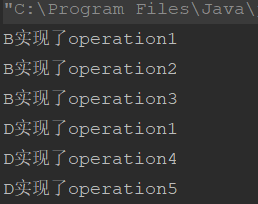学习笔记【23种设计模式-第一节:设计模式的七大原则及初步了解UML】
设计模式的作用
- 代码重用性(即相同功能的代码,不用多次编写)
- 可读性(即编程规范性,便于其他程序员的阅读和理解)
- 可扩展性(即当需要增加新的功能时,非常方便)
- 可靠性(即当增加新的功能后,对原来的功能没有影响)
- 使程序程先高内聚低耦合的特性。
设计模式常用的七大原则:
- 单一职责原则
简述:
对类来说,及一个类应该只负责一项职责,如类A负责两个不同职责:职责1,职责2。当职责1需求变更而改变A时,可能造成职责2执行错误,所以需要将类A的粒子分解为A1,A2。可在方法级别上(其实不是真正的遵守,倘若职责简单可用),类级别上遵守,以实际业务为准。
注意事项:
- 降低类的复杂度,一个类只负责一项职责。
- 提高类的可读性,可维护性
- 降低变更引起的风险
- 通常情况下,我们应当遵守单一职责原则,只有逻辑足够简单,才可以在代码级违反单一职责原则;只有类中的方法数量足够少,可以在方法级别保持单一职责原则。
- 接口隔离原则(Interface Segregation Principle)
简述:
- 客户端不应该依赖它不需要的接口,及一个类对另一个类的依赖应该建立在最小的接口上。
- 若类B与类D实现了Interface1接口,类A通过接口Interface1依赖类B,类C通过接口Interface1依赖于类D。如果接口Interface1对于类A和类C来说不是最小的接口,那么类B和类D必须去实现他们不需要的方法。
- 按隔离原则应当这样处理:
将接口interface1拆分为独立的几个接口,类A和类C分别于他们需要的接口建立依赖关系,也就是采用接口隔离原则。
接口隔离后:
public class Segregation1 {
public static void main(String[] args) {
A a=new A();
a.depend1(new B());
a.depend2(new B());
a.depend3(new B());
C c=new C();
c.depend1(new D());
c.depend2(new D());
c.depend3(new D());
}
}
interface Interface1{
void operation1();
}
interface Interface2{
void operation2();
void operation3();
}
interface Interface3{
void operation4();
void operation5();
}
class B implements Interface1,Interface2{
@Override
public void operation1() {
System.out.println("B实现了operation1");
}
@Override
public void operation2() {
System.out.println("B实现了operation2");
}
@Override
public void operation3() {
System.out.println("B实现了operation3");
}
}
class D implements Interface1,Interface3{
@Override
public void operation1() {
System.out.println("D实现了operation1");
}
@Override
public void operation4() {
System.out.println("D实现了operation4");
}
@Override
public void operation5() {
System.out.println("D实现了operation5");
}
}
class A{
public void depend1(Interface1 i){
i.operation1();
}
public void depend2(Interface2 i){
i.operation2();
}
public void depend3(Interface2 i){
i.operation3();
}
}
class C{
public void depend1(Interface1 i){
i.operation1();
}
public void depend2(Interface3 i){
i.operation4();
}
public void depend3(Interface3 i){
i.operation5();
}
}
- 依赖倒转(倒置)原则(Dependence Inversion Principle)
简述:
- 高层模块不应该依赖底层模块,二者都应该依赖于其抽象;
- 抽象不应该依赖细节,细节应该依赖抽象;
- 依赖倒转的中心思想是面向接口编程。
- 依赖倒转原则是基于这样的设计理念:相对于细节的多边形,抽象的东西要稳定的多。一抽象为基础搭建的架构比以西结为基础的架构要稳定的多。在java中,抽象指的是接口或抽象类,细节就是具体的实现类。
- 使用接口或抽象类的目的是制定好规范,而不涉及任何具体的操作,把展现细节的任务交给他们的实现类去完成。
例子:
public class DependencyInversion {
public static void main(String[] args) {
Person person=new Person();
person.receive(new Email());
person.receive(new WeChat());
}
}
interface IReceiver{
public String getInfo();
}
class Email implements IReceiver{
public String getInfo(){
return "电子邮件信息:HelloWorld!";
}
}
class WeChat implements IReceiver{
public String getInfo() {
return "微信:Hello Baby!";
}
}
class Person{
public void receive(IReceiver receiver){
System.out.println(receiver.getInfo());
}
}
通过接口传递实现依赖:
public class DependencyInversion02 {
public static void main(String[] args) {
ChangHong changHong=new ChangHong();
OpenAndClose openAndClose=new OpenAndClose();
openAndClose.open(changHong);
}
}
interface IOpenAndClose{
public void open(ITV tv);
}
interface ITV{
public void play();
}
class ChangHong implements ITV{
@Override
public void play() {
System.out.println("长虹电视打开!!");
}
}
//实现接口
class OpenAndClose implements IOpenAndClose{
@Override
public void open(ITV tv) {
tv.play();
}
}
通过构造方法依赖传递:
public class DependencyInversion03 {
public static void main(String[] args) {
MeiDi meiDi=new MeiDi();
OpenAndClose2 openAndClose2=new OpenAndClose2(meiDi);
openAndClose2.open();
}
}
interface IOpenAndClose2{
public void open();
}
interface ITV2{
public void play();
}
class MeiDi implements ITV2{
@Override
public void play() {
System.out.println("美的电视打开!!");
}
}
class OpenAndClose2 implements IOpenAndClose2 {
public ITV2 tv;
public OpenAndClose2(ITV2 tv) {
this.tv = tv;
}
@Override
public void open() {
tv.play();
}
}
通过setter方法传递:
public class DependencyInversion04 {
public static void main(String[] args) {
TCL tcl=new TCL();
OpenAndClose3 openAndClose3=new OpenAndClose3();
openAndClose3.setTv(tcl);
openAndClose3.open();
}
}
interface IOpenAndClose3{
public void open();
}
interface ITV3{
public void play();
}
class TCL implements ITV3{
@Override
public void play() {
System.out.println("TCL电视打开!");
}
}
class OpenAndClose3 implements IOpenAndClose3{
private ITV3 tv;
public void setTv(ITV3 tv) {
this.tv = tv;
}
@Override
public void open() {
tv.play();
}
}
注意事项:
- 底层模块尽量都要有抽象类和接口,或者两者都有,程序稳定性更好。
- 变量的声明类型尽量是抽象类或接口,这样我们的变量引用和实际对象间,就存在一个缓冲层,利于程序扩展和优化。
- 继承时遵循里氏替换原则
- 里氏替换原则(Liskov Substitution Principle)
简述:
- 里氏替换原则在1998年,由麻省理工学院的一位姓里的女士提出的。
- 如果对每个类型位T1的对象o1,都有类型位T2的对象o2,使得以T1定义的所有程序P在所有的对象o1都带换成o2时,程序P的行为没有发生变化,那么类型T2时类型T1的子类型。换句话说,所有引用基类的地方必须能透明的使用其子类的对象。
- 在使用继承时,遵循里氏替换原则,在子类中尽量不要重写父类的方法。
- 里氏替换原则告诉我们,继承实际上让两个类耦合性增强了,在适当的情况下,可以通过聚合,组合,依赖来解决问题。
B类原继承A类,改进后:
class Base{}
class A extends Base{
public int func1(int n1,int n2){
return n1-n2;
}
}
class B extends Base{
private A a=new A();
public int func1(int n1, int n2) {
return n1+n2;
}
public int func2(int n1,int n2){
return func1(n1, n2)+9;
}
public int func3(int n1,int n2){
return a.func1(n1,n2);
}
}
- 开闭原则ocp(Open Closed Principle)
简述:
- 是编程中最基础最重要的设计原则。
- 一个软件实体如类,模块和函数应该对扩展开放,对修改关闭。用抽象构建框架,用实现扩展细节。
- 当软件需要变化时,尽量通过扩展软件实体的行为来实现变化,而不是通过修改已有的代码来实现变化。
- 编程中遵循其他原则,以及使用设计模式的目的就是遵循开闭原则。
例子(绘制图形):
class GraphicEditor{
public void drawShape(Shape s){
if (s.m_type==1) drawRectangle(s);
else if (s.m_type==2) drawCircle(s);
}
public void drawRectangle(Shape r){
System.out.println("绘制矩形");
}
public void drawCircle(Shape r){
System.out.println("绘制圆形");
}
}
class Shape{
int m_type;
}
class Rectangle extends Shape{
Rectangle(){
super.m_type=1;
}
}
class Circle extends Shape{
Circle(){
super.m_type=2;
}
}
我们发现,倘若要加一个新的图形,会有很多的修改,不符合OCP原则。
改进后:
public class OCPTest {
public static void main(String[] args) {
GraphicEditor graphicEditor=new GraphicEditor();
graphicEditor.drawShape(new Circle());
graphicEditor.drawShape(new Rectangle());
}
}
class GraphicEditor{
public void drawShape(Shape s){
s.draw();
}
}
abstract class Shape{
int m_type;
public abstract void draw();
}
class Rectangle extends Shape{
Rectangle(){
super.m_type=1;
}
@Override
public void draw() {
System.out.println("绘制矩形");
}
}
class Circle extends Shape{
Circle(){
super.m_type=2;
}
@Override
public void draw() {
System.out.println("绘制圆形");
}
}
class Triangle extends Shape{
Triangle(){
super.m_type=2;
}
@Override
public void draw() {
System.out.println("绘制三角形");
}
}
- 迪米特原则(Demeter Principle)
简述:
- 一个对象应该对其他对象保持最少的了解
- 类与类关系越密切,耦合度越大
- 迪米特法则又叫最少知道原则,即一个类对自己依赖的类知道的越少越好。也就是说,对于被依赖的类不管多么复杂,都尽量将逻辑封装在类的内部。对外除了提供的public方法,不对外泄露任何信息。
- 迪米特法则还有一个更简单的定义:只与直接的朋友通信。
- 直接的朋友:每个对象都会与其他对象有耦合关系,只要两个对象之间有耦合关系,我们就说这两个对象之间是朋友关系。耦合的方式有很多,依赖,关联,组合,聚合等。其中,我们称出现成员变量,方法参数,方法返回值中的类为直接的朋友,而出现在局部变量的类不是直接的朋友,也就是说,陌生的类最好不要以局部变量的形式出现在类的内部。
小结:
- 迪米特法则的核心是降低类之间的耦合。
- 注意:由于每个类都减少了不必要的依赖,音痴迪米特法则只是要求降低类间(对象间)的耦合关系,并不是要求完全没有依赖关系。
- 合成复用原则(Composite Reuse Principle)
原则是尽量使用合成/聚合的方式,而不是使用继承。
因为继承关系的耦合度太强,所以一般设计时我们会将关系转换为依赖,聚合或者是组合。
依赖(合成):
如有一个类A,中间有3个方法,一个类B只想用其中的一个方法,可以将A设为方法的参数类型,然后用a调A中的方法。
聚合:
如有一个类A,中间有3个方法,一个类B只想用其中的一个方法,还可以在类B中设一个A的属性,然后用A中的方法。
**组合:**在类B中实例化了一个类A,A a=new A();。
设计原则的核心思想
- 找出应用中可能需要变化之处,把他们独立出来,不要和哪些不需要变化的代码混在一起。
- 针对接口编程,而不是针对实现编程。
- 为了交互对象之间的松耦合设计而努力。
知识补充:UML
UML Unified modeling language 统一建模语言
是一种用于软件系统分析和设计的语言工具,它用于帮助团建开发人员进行思考和记录思路的结果。
六大关系
dependency 依赖
- 类中用到了对方
- 如果是类的成员属性
- 如果是方法的返回类型
- 是方法接收的参数类型
- 方法中使用到
Generalization 泛化(继承)
- 就是继承关系
- 是依赖关系的特例
Implementation 实现
- A类实现了B类
- 是依赖关系的特例
Association 关联
- 类与类之间的联系,是依赖关系的特例
- 关联具有导航性,即双向关系或单向关系
- 单向一对一关系:比如类Person中有类IDCard这个属性。
- 双向一对一关系:比如类Person中有类IDCard这个属性,类IDCard中也有类Person这个属性。
Aggregation 聚合
- 整体和部分的关系,整体和部分是可以分开的。
- 是关联关系的一种特例,所以具有关联的导航性和多重性。
- 如:一台电脑有键盘(keyboard)、显示器(monitor)、鼠标等组成;组成电脑的各个配件是可以从电脑上分离出来的,使用带空心菱形的实线来表示。
- 类电脑中创建了键盘(keyboard)、显示器(monitor)、鼠标等的属性。
Composite 组合
- 也是整体和部分的关系,但是整体和部分不能分开。
- 如:Person与Head是组合,Person和IDCard可以是聚合。
- 上面的例子,倘若键盘(keyboard)、显示器(monitor)、鼠标等和电脑是不可分离的,则是组合关系,实心菱形的实现来表示。
- 类电脑中创建了键盘(keyboard)、显示器(monitor)、鼠标等的实例化对象。
下一篇:学习笔记【23种设计模式-第二节:Singleton单例模式】
